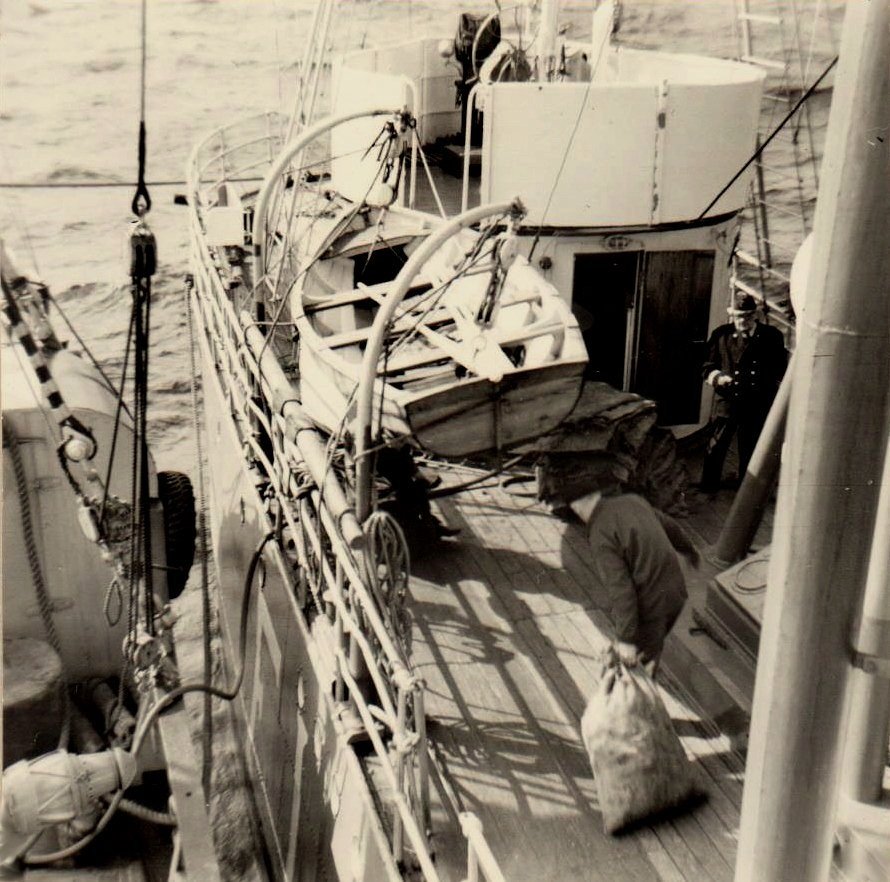Construction:
In 1892, the vessel was built at Kockums Mekaniska Verkstad in Malmo using steel. When fully equipped, it weighed approximately 308 tons, was about 31.5 meters in length, and 6.1 meters wide. The crew consisted of eight men, and it was powered by a steam engine generating 180 horsepower.
Description:
The ship was a red lightship with two masts, the mainmast featuring a top ball, and the name FLADEN painted in large white letters on the sides with its number on the stern. It had a flush deck and a short bow. A hoistable lantern surrounded the mainmast.
Lighthouse:
The red flashing light, consisting of a group of four, was visible every 30 seconds. The lighthouse apparatus comprised eight parabolic mirrors illuminated by kerosene lamps. The light source was located 9.5 meters above the waterline, and its range extended to 11 nautical miles.
During the day, the lighthouse apparatus was stored in a deckhouse at the bow to protect it from the weather and sea.
The lantern was constructed around the mainmast and ran in a guide when it was raised or lowered. The Stevenson-type lantern and lighthouse apparatus were made by G.W. Lyth in Stockholm and contained eight kerosene lamps in individual silvered, gimbal-mounted parabolic mirrors arranged in four groups. The mirrors had a diameter of 50 cm and produced 1,040 Hefner candles of light. The mirror-based lighthouse apparatus was powered by a clock and plumb bob and produced the red flashing light consisting of four blinks every 30 seconds.
Sound Signals:
During foggy conditions, the mist siren sounded four blasts every minute, each lasting four seconds and separated by a four-second pause. After the last blast, there was a 32-second pause. If the siren malfunctioned, a bell would ring four times in quick succession every minute. If the ship observed that another vessel was heading towards a shallow area, it would fire warning shots.
Modifications
1927
A tower with lantern and lens was installed.
The 5th order lens (375 mm Ø) was gimbal-mounted in its center of gravity with a pendulum and equipped with Dalén light.
Luminous intensity: 3,800 Hefner candles.
Light height: 10.5 m.
Range: 11 M.
Light character: white flash every 30 seconds.
An underwater bell was installed.
1951
A radiotelephone was installed.
1953
The steam engine was replaced by a 200 hp crude oil engine.
Two smaller crude oil engines were installed for generators and the compressor for the typhoon.
The lighthouse was electrified.
The Dalén light was replaced by a 1000 W electric light bulb.
Luminous intensity: 27,000 Hefner candles.
1957
A circular radio beacon was installed.
Frequency: 408.0 kHz.
Range: 10 nm.
1961
The Fladen lighthouse station had the light character Mo ( _ . ) W 20 s 11 M.
A stationary lens with a light bulb.
Luminous intensity: 27,000 HK.
Fog signal: Typhoon 4 blasts every 60 seconds (3 + 2 + 3 + 2 + 3 + 2 + 3 + 42).
Service history:
1892-1899, it served as a lighthouse ship at Fladen.
1900-1929, it served as a lighthouse ship at Grisbådarna.
1930-1965, it served as a lighthouse ship at Fladen.
During the years of World War II, from 1939-1946, it served as a base for pilotage operations in northern Bohuslän. Here, pilots were exchanged for vessels in the so-called convoy traffic (Gothenburg traffic) on incoming and outgoing routes. Norwegian pilots were present for outbound traffic, and Swedish pilots were present when the course was set for Gothenburg.
Many refugees, mostly Norwegians, found temporary shelter here before continuing to Sweden.
1967 she was sold. Before the sale, the lantern and machinery were removed.
She was then rebuilt as a sports fishing vessel at the Rönnäng shipyard. It was used on both the west and east coasts.
The new owners kept the name "Fladen" on the ship. It was converted into a floating clothing store and spent several summers at the docks in Lysekil and Kungshamn. They sold clothes and also used the ship as a youth disco.
1977 the ship was sold to the film company Fladen Film.
2013 The ship was sold to its current owner and is located at Norra Brobänken, Skeppsholmen, Stockholm.










